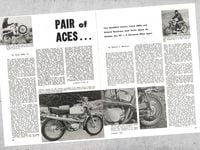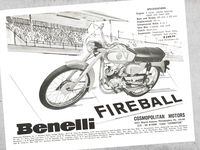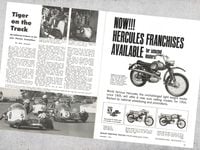Pair of Aces
This was an interesting "set" of articles. Both were written as a review of the Hodaka Ace 90 and were presented side by side in the January 1966 issue of Motorcyclist, but not as a collaborated article. In fact, the way the reviews are laid out on the pages, the Millis article is continued after the first page to the back of the magazine (page 45) to allow the Renstrom article to begin on the facing page. Renstrom's article also continues on page 45 after a short hop to page 31. The final page (45) contains two separate conclusions.
Frank Millis—Millis starts out with some history of the smaller Japanese motorcycle beginning with Soichiro Honda in 1959. Honda showed the viability of smaller motorcycles in the American marketplace that were not "thunderously fast big twins that cruise the open highways in chromium-plated splendor". What the Japanese machines brought to market were motorcycles that could usable transportation during the week and suitable for weekend sporting activities.
The machine in question was a Hodaka Ace 90. The brand had come to America only a year and a half earlier. What Millis points out as the main strength (literally) of the Ace is the sturdy double-loop frame coupled with strong forks. Also sturdy by Frank’s standards was the rear suspension.
The frame and suspension was not the only thing that made this little Hodaka appealing though. The engine; although completely orthodox, managed to post respectable pony power. He did not quote numbers but did say that he flogged this machine hard and found no hill it would climb. Since the bike comes with both a 32- and a 46-tooth sprocket, he pointed out that no hill bested him with either installed.
Tested at 5,600 feet, he was able to achieve 60 mph without having to “resort to lying down on the gas tank or other assorted wind-foiling gymnastics”. This speed although excellent in it’s class came with a small warning, don’t try to keep up with fast moving traffic. He also found the brakes good and road-handling ability to be favorable. Of minor note was that he did occasionally have issue finding neutral yet the transmission did shift well after a hard day’s use….or rather misuse.
After a hard day of relentless wrenching on the throttle tube, Millis observed a cool 100 mpg which could easily be increased yet a half again if ridden conservatively. There were only two things he thought could use improvement. The rear suspension is roadworthy but a bit too stiff and the headlight dimmer featured the “OFF” position between “LOW” and “HIGH”.
His final thoughts on the Hodaka Ace 90 are this: "The machine does what it is supposed to do and does it well. If you want a lightweight, low-cost motorcycle that can handle weekly commutes and sporting purposes including tax-evasion, this is the machine for you. It’s economy and ability make it a good motorcycle."
Richard C. Renstrom—Renstrom pointed out that for a third of the cost, a smaller bike might be a good plan. The motorcycling community was booming at this point and there was a large crop of small bikes to choose from. The hard part was finding a machine that would "...do a good job of both pavement riding and rough-stuff scrambling or trail riding…"
During the design, Hodaka tested the bike in the northwestern United States in the areas of eastern Oregon, eastern Washington, and western Idaho. With input from local riders, the Ace 90 was born at a paltry $363 Renstrom thought it to be the best sub-100 cc for dual-purpose use.
From here, the author took a more technical track when reviewing the Ace 90. The most distinguishing feature he could see was the frame. Unlike the pressed steel frames offered by most manufacturers, the Ace had no torsional twist. A high pipe combined with an amazing 8 inches of ground clearance enhanced it off-pavement suitability. Further supporting its dual-purpose bent is the telescopic forks which had an exceptional amount of travel for a small bike.
The 17-inch wheels had “universal” tread with good traction in the dirt even though they were essentially a street tire. The rugged steel fenders really speak to the quality of the machine. While looking below, Renstrom also noted that the alloy brake hubs are adequate for the speed of the machine.
The 8.90 cc two-stroke single lays down 5 HP at 7,500 rpm and give the rider 5.1 pounds of torque at 5,500 rpm. This is a relatively high-revving motor with a 9.5:1 compression ratio from a nearly square 48 mm X 50 mm bore and stroke.
Further notes on the engine include, a crank and tranny in one sealed unit with it’s own gear oil bath while the top end is lubricated by the gas-oil mix. There is no mention of a oil injection system so it is assumed by the modern writer to be pre-mix situation. The electrics are powered by a flywheel mounted magneto and a 6 volt battery. The gearbox has a wide ratio range from 9.04 to 28.6 which give it the ability to ride the macadam and the dirt equally as well. Also included with the motorcycle are two sprockets and there are also five additional sizes available. Renstrom points out that this “...gives an owner a choice of low enough ratios for all but telephone climbing.”
In regards to fit and finish, Renstrom said it was of unusually high quality.
- Exhaust – The pipe is high for clearance, has a really good shield to protect the leg from burns. The silencer has a crisp exhaust note without being objectionable.
- Tank – Nicely shaped and chromed.
- Seat – Big and comfortable for longer rides or hauling double.
- Electrical System – Well designed.
- Lighting – There is a 5 inch sealed beam headlight and a good, bright tail light.
With a 45-inch wheelbase and weighing in at 155 pounds, the Ace travels well from light to light and has a cruising speed of 40-45 mph and top speed of around 60 mph, although no speed tests were conducted.
When tested around town, it was found to be capable like most bikes in it’s class. For the more serious testing, the hills were tackled. Here was the only point of criticism by Renstrom. He felt that the forks were too soft for “any go-fast work”. He mentions that for a few dollars you could get a set of higher tension springs. For any serious off-pavement riding, he would recommend them.
In the dirt, the high revving, wide-ratio gearbox excelled over other machines in the ultra-lightweight category. With this combination, the 90 cc was able to make up for the lack of inches.
Without getting too radical with the engine design, Hodaka has produced a well-rounded machine with a broader spectrum of power that makes up for it’s size and this had been proven in competition at the time of publishing of this article. At the famous Greenhorn Enduro, the Hodaka was the first sub-100 cc machine to ever officially complete the race. It had also been establishing itself at other events around the country as “Top Dog”.
Small in stature and price, this machine could sit in a corner of the garage and be used for a wide variety of purposes. It also has a 150-160 mpg mileage estimate which reinforces the economy of the machine. According to Renstrom, this was a winning combination for a person looking for a small go-anywhere machine that was not intimidating and could make any rider an expert in a day.
Tiger on the Track
Florian Camathias was thought of as one of Europe's most popular racers in the mid-1960s by Mick Wollett. For this reason it was tragic when he lost his life at the Brands Hatch circuit near London.
To look upon this middle-aged, owlish little man with rimless spectacles you would have no idea how much of an impact he had on motorcyclists in every country he raced. What endeared him to the crowds was his daring. He did things by sheer force of will that skilled riders did with the aid of strength and skill. He rode just as hard at a local event as he would at world championship events and was know as a real tiger of the track. At the same time, Camathias was known to be cheerful and friendly.
Born, raised and living in Switzerland, he started racing in 1947. He started as many do, riding a solo rig. He continued this until the early fifties until he fractured his skull and had to leave the sport for a year. In 1955 he returned like so many Swiss before him by starting competition in the sidecar class. He bought a BMW and started to make an impression.
By this time he had his own motorcycle shop on the banks of Lake Geneva. In his workshop he started to develop and improve upon his sidehack. Since he didn’t have access to the BMW “Works” engines he concentrated on decreasing the weight of the machine, getting them closer to the ground, and improving aerodynamics.
Part of his ferocious tendencies was a knack for over-revving the BMW engines without blowing them up. In 1957 this hard work started paying off. He started winning and continued to do so until his untimely death.
It is sad and ironic to note that his death was caused by some bad brazing on a set of forks he built. Over 100 people attended his funeral. He left a wife and a million fans behind. The sport had lost an incredible character who did a lot to enrich motorcycle racing.










/cloudfront-us-east-1.images.arcpublishing.com/octane/4CQ27CCHKXRLGANEHUX72EEYVY.jpg)








/cloudfront-us-east-1.images.arcpublishing.com/octane/7GJYDUIPXRGMTMQKN6ONYOLBOU.jpg)
/cloudfront-us-east-1.images.arcpublishing.com/octane/MUQLOVLL2ZDGFH25ILABNBXKTI.jpg)
/cloudfront-us-east-1.images.arcpublishing.com/octane/TNOU5DNE2BC57MFPMGN2EIDXAM.jpg)
/cloudfront-us-east-1.images.arcpublishing.com/octane/GTCXACQGJ5HAPDTGWUQKDEH44E.jpg)
/cloudfront-us-east-1.images.arcpublishing.com/octane/S35YGSEMEZB4BLTDJTSZPF4GLA.jpg)
/cloudfront-us-east-1.images.arcpublishing.com/octane/5UOT6HPX2JFMRJAX6EH45AR4MQ.jpg)
/cloudfront-us-east-1.images.arcpublishing.com/octane/OKWOJWAKP5EP3OACCRRWPCIX2Q.jpg)
/cloudfront-us-east-1.images.arcpublishing.com/octane/2WF3SCE3NFBQXLDNJM7KMXA45E.jpg)
/cloudfront-us-east-1.images.arcpublishing.com/octane/G4MG6OUCJNBSHIS2MVVOTPX65E.jpg)
/cloudfront-us-east-1.images.arcpublishing.com/octane/IIGGWFOTOJGB7DB6DGBXCCMTDY.jpg)
/cloudfront-us-east-1.images.arcpublishing.com/octane/QSTCM6AVEZA5JJBUXNIQ3DSOF4.jpg)
/cloudfront-us-east-1.images.arcpublishing.com/octane/U4I7G625B5DMLF2DVIJDFZVV6M.jpg)
/cloudfront-us-east-1.images.arcpublishing.com/octane/B6XD6LS6IVCQPIU6HXDJSM3FHY.jpg)
/cloudfront-us-east-1.images.arcpublishing.com/octane/ICL63FEDDRDTTMINYICCEYGMDA.jpg)
/cloudfront-us-east-1.images.arcpublishing.com/octane/FCGZHQXRBZFLBAPC5SDIQLVF4I.jpg)
/cloudfront-us-east-1.images.arcpublishing.com/octane/WNOB6LDOIFFHJKPSVIWDYUGOPM.jpg)

/cloudfront-us-east-1.images.arcpublishing.com/octane/X33NU3E525ECRHXLNUJN2FTRKI.jpg)
/cloudfront-us-east-1.images.arcpublishing.com/octane/6KKT5NNL2JAVBOXMZYS5ZO76YA.jpg)
/cloudfront-us-east-1.images.arcpublishing.com/octane/J5RKG5O455GMPGQRF2OG6LRT7A.jpg)
/cloudfront-us-east-1.images.arcpublishing.com/octane/GX2CIZKQVRH2TATDM26KFG2DAE.jpg)
/cloudfront-us-east-1.images.arcpublishing.com/octane/ZWIDYSAKQZHD5BHREMQILXJCGM.jpg)
/cloudfront-us-east-1.images.arcpublishing.com/octane/CYUHJZCTSJCH3MRAQEIKXK7SCQ.jpg)
/cloudfront-us-east-1.images.arcpublishing.com/octane/LKOFINY56FCXJCANJ5M7ZDQUBY.jpg)